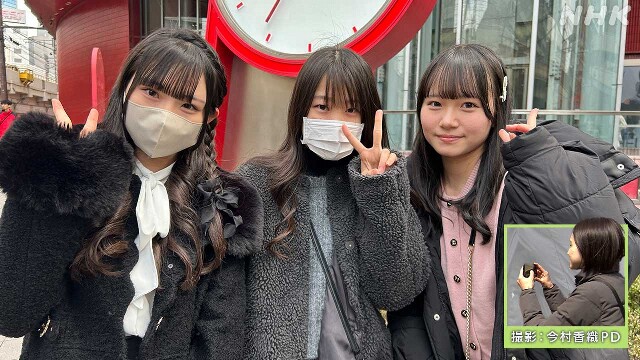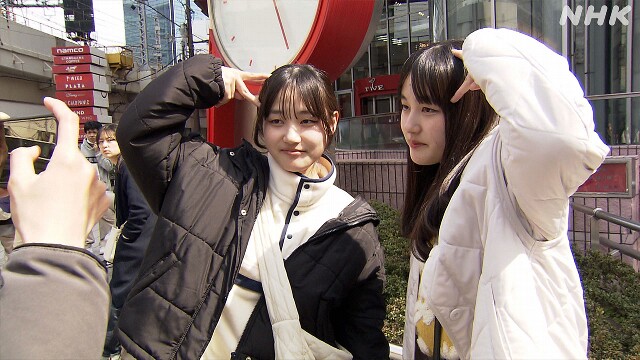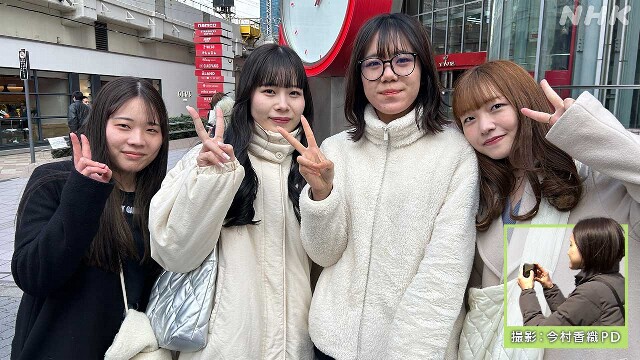TOKYO, Mar 20 (News On Japan) - Graduation ceremonies, cherry blossom viewing, and entrance ceremonies. It's a season filled with opportunities to take "photos," but when someone says, "Say cheese!" what kind of pose do you strike? Do you find yourself making a peace sign?

The Ubiquitous Peace Sign
When we approach people on the street to take their photos... Indeed, the peace sign is a common choice. Out of 59 people we asked, 47 made the peace sign. That's over 80%. So we asked them, "Why did you make a peace sign?" Responses varied: "Hmm! The first thing that comes to mind is the peace sign," "It's classic," "It's a staple," "When you think of photos, you think of the peace sign." It seems that no one has a definitive reason, yet the peace sign is an automatic response for many.

The Origin of the Peace Sign
Our first stop was the Osaka City Central Library. We scoured through books filled with photographs, such as "Photography Yearbooks" and "Local Government Photo Histories," searching for any clues about when people started making peace signs. However, we found no leads... In the era of black and white photography, there were no peace signs to be seen in family or group photos. Most people stood rigid, often without smiles. Quite a puzzle.
Upon consulting with a librarian... "We have something here about how the V-sign has been used," they offered us an article from the 1991 issue of "Chuo Koron." The piece, part of a series called "Body Tradition Notes" by cultural anthropologist Masakazu Nomura, revealed that the sign, made by raising the middle and index fingers, originally spread in Europe during World War II as the "V-sign." It signified victory over Nazi Germany, "Victory," and became a symbol of solidarity among the Allied forces. Numerous photos of Winston Churchill, the British Prime Minister at the time, show him making this V-sign.

The V-sign transformed into the "peace sign" in the 1960s, during the anti-Vietnam War movement, symbolizing a wish for peace. According to Nomura, "The theory that it started when American hippies and anti-war activists showed it to police officers is well-supported." Some experts suggest that the young people who were rebelling against established values repurposed the victory sign as a symbol of peace.

But why did it catch on in Japan?
Seeking clues, we reached out to major camera manufacturers. One company provided a compelling lead: "We're not certain, but it might have started with actor Jun Inoue."
Before his appearance on NHK's "Radio Midnight Flight," we asked Inoue, "We heard that you were the one who popularized it in Japan. Is that true?"
Inoue: "It's a long story, might take about two years to tell (laughs). About half a century ago, around 1970, I went to America for a camera advertisement shoot. At that time, America was in the middle of the Vietnam War, deep in the anti-war movement. Everyone I met would say, 'Jun, peace!' 'Peace, Jun!' I wondered what it was about and when I asked, they said, 'In America, everyone says peace for the anti-war movement.' I'm the type to adapt quickly (laughs), so I was like, 'Oh, I see.' When the shooting started, I threw in a peace sign as an ad-lib. It was just for fun. But when I returned to Japan and saw the broadcast, they had used the photo with the peace sign and I was like, 'Wow!'"
The advertisement featuring Inoue's peace sign can indeed be found in a 1972 camera advertisement. He's holding the camera with one hand and making a peace sign with the other, all while sporting a beaming smile.
Inoue: "After a while, as I walked around town, people started saying 'peace' to me out of the blue. In return, I'd also say 'peace,' and it wasn't just one person; more and more people started saying it as the days went by. Gradually, it became widespread in society."
Photo critic Manabu Torihara points out that Inoue's peace sign had a significant impact on the spread of the gesture in Japan.
Torihara: "That commercial had a strong impact. I remember imitating it myself, and during school trips or excursions, we would make the peace sign in front of the camera. With the backdrop of the anti-Vietnam War movement, Inoue's shout of 'Peace!' transformed what had been known as the V-sign into the 'peace sign,' and it became overwhelmingly popular in conjunction with the camera advertisement."
NHK's past footage also suggests that the number of people making peace signs in Japan began to increase around the 1970s.
Inoue: "Smiles are incredibly important, and I hope this peace sign, which contributes to smiles, will continue to spread. Peace!!"
The Evolving Peace Sign
Looking closely at the peace signs made by the people we approached on the street, it seems there are variations different from Inoue's original sign.

The cat-ear pose, with the peace-sign hand placed on the head. The gal peace, with the hand flipped and fingertips pointing down. We confirmed a variety of these evolutions. According to Serina Okuma, editor-in-chief of the magazine "egg," the peace sign is evolving.
Okuma: "The regular peace sign, brought close to the face (1) the small-face peace, flipped over (2) the reverse peace, moved down (3) the chin peace, and last year's explosive trend (4) the gal peace. With the emergence of various media and an increase in aspirational figures, it's natural that trends are born faster and in greater numbers."
Reflecting aspirational figures, we also found people making poses other than the peace sign.
The "heart" was popular ("I'm in your heart!" expressing this sentiment, originally done with both hands, has recently become a one-handed gesture). Many people imitated poses of idols."
Okuma: "It's not easy to say 'This pose is the trend' in a single phrase. Everyone, without exception, is making the pose they think is attractive, the pose they believe they look best in. That's the sensibility of today's youth."
We asked Inoue again about the evolution of the peace sign and the diversification of poses.
Inoue: "Reverse peace? If I did that, I'd get cramps in my hands (laughs). Whether it's reverse or not, I just hope it's used in a good way. With all the disputes and sad news lately, I hope for a world where we think of others' feelings, where saying 'peace' brings a bright smile, and that sentiment reaches others. I pray for such a world."
The peace sign has become ingrained in Japan's culture. It will be interesting to see how it changes with the times.

No Peace Signs Overseas?
During our street interviews, we also approached tourists from abroad. When we said, "Say cheese!" and took their photos... Most did not make the peace sign. Since the inverted peace sign can be an insult in some regions, foreigners tended to choose simpler poses like "shoulder to shoulder" or "showing a smile." We discovered that poses for photos can vary by country.
Director Kaori Imamura, Osaka Broadcasting Station, 2023, was surprised by the lack of peace signs during her studies abroad. She thought people had stopped using it, but... it turns out it is still used quite often. Reporter Shinya Fujishima, Osaka Broadcasting Station, joined in 2009, found himself unconsciously making a peace sign when checking recent photos on his smartphone.
Source: NHK














